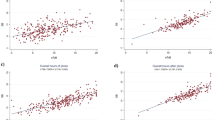Abstract
OBEJECTIVE: To compare transcutaneous bilirubin readings from the chest and forehead of inpatient and outpatient infants to investigate whether one site is more accurate for estimating serum bilirubin concentration.
METHODS: In all, 31 infants were followed with serum and transcutaneous bilirubins using BiliChek™ at two skin sites.
RESULTS: For inpatients average chest bilirubin was 0.4 mg/dl (7 μmol/l) higher than serum while brow was 0.3 mg/dl (5μmol/l) lower. For outpatients, skin readings from both sites underestimated serum values. Chest estimates were 0.6 mg/dl (10 μmol/l) lower; brow was 2.1 mg/dl (36 μmol/l) lower (p<0.0001). Correlation coefficients and mean differences between skin and serum values for Hispanic and non-Hispanic infants were similar.
CONCLUSIONS: In our inpatients, chest and brow readings approximated serum values. After discharge, brow readings were lower than serum values by almost 20%, while chest readings were underestimated by 5%. We recommend using the chest for transcutaneous bilirubin estimates.

Similar content being viewed by others
References
Bhutani VK, Gourley GR, Adler S, Kreamer B, Dalin C, Johnson LH . Noninvasive measurement of total serum bilirubin in a multiracial predischarge newborn population to assess the risk of severe hyperbilirubinemia. Pediatrics 2000;106:E17.
Rubaltelli FF, Gourley GR, Loskamp N, et al. Transcutaneous bilirubin measurement: a multicenter evaluation of a new device. Pediatrics 2001;107:1264–1271.
Ebbesen F, Rasmussen LM, Wimberley PD . A new transcutaneous bilirubinometer, BiliCheck, used in the neonatal intensive care unit and the maternity ward. Acta Paediatr 2002;91:203–211.
Robertson A, Kazmierczak S, Vos P . Improved transcutaneous bilirubinometry: comparison of SpectR(X) BiliCheck and Minolta Jaundice Meter JM-102 for estimating total serum bilirubin in a normal newborn population. J Perinatol 2002;22:12–14.
Engle WD, Jackson GL, Sendelbach D, Manning D, Frawley WH . Assessment of a transcutaneous device in the evaluation of neonatal hyperbilirubinemia in a primarily Hispanic population. Pediatrics 2002;110:61–67.
Armitage P . Statistical Methods in Medical Research. Oxford, UK: Blackwell Scientific Publications; 1980 p. 279–301.
Yamauchi Y, Yamanouchi I . Factors affecting transcutaneous bilirubin measurement: effect of daylight. Acta Paediatr Jpn 1991;33:658–662.
Author information
Authors and Affiliations
Additional information
This work was supported in part by the University of New Mexico Clinical Research Center (NIH NCRR GCRC Grant 5M01 RR0997) and the Wellspring Pharmaceutical Corporation, Neptune, NJ, USA.
Rights and permissions
About this article
Cite this article
Poland, R., Hartenberger, C., McHenry, H. et al. Comparison of Skin Sites for Estimating Serum Total Bilirubin in In-Patients and Out-Patients: Chest Is Superior to Brow. J Perinatol 24, 541–543 (2004). https://doi.org/10.1038/sj.jp.7211141
Published:
Issue Date:
DOI: https://doi.org/10.1038/sj.jp.7211141
- Springer Nature America, Inc.
This article is cited by
-
Evaluation of transcutaneous bilirubinometer (DRAEGER JM 103) use in Zimbabwean newborn babies
Maternal Health, Neonatology and Perinatology (2018)
-
Comparison of a new transcutaneous bilirubinometer (Bilimed®) with serum bilirubin measurements in preterm and full-term infants
BMC Pediatrics (2009)
-
Evaluation of a Transcutaneous Jaundice Meter Following Hospital Discharge in Term and Near-Term Neonates
Journal of Perinatology (2005)




